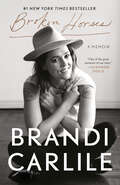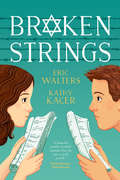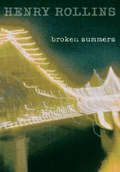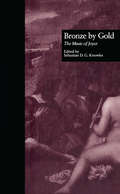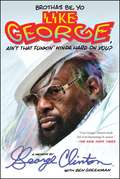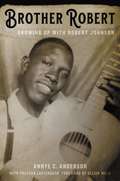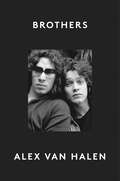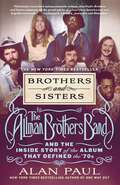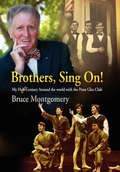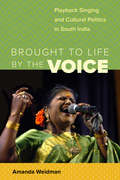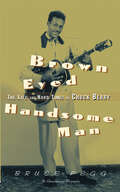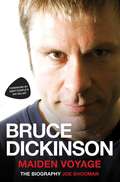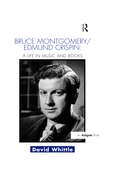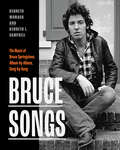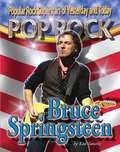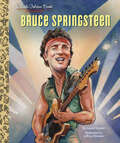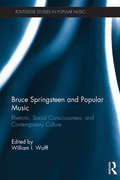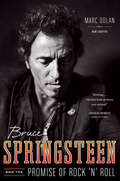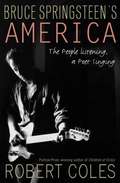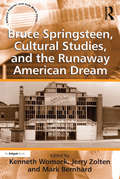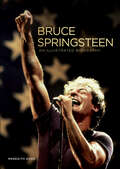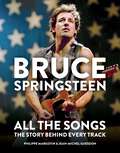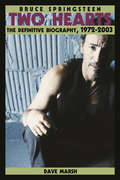- Table View
- List View
Broken Horses: A Memoir
by Brandi CarlileThe critically acclaimed singer-songwriter, producer, and six-time Grammy winner opens up about a life shaped by music in this candid, heartfelt, and intimate story. <P><P>Brandi Carlile was born into a musically gifted, impoverished family on the outskirts of Seattle and grew up in a constant state of change, moving from house to house, trailer to trailer, fourteen times in as many years. Though imperfect in every way, her dysfunctional childhood was as beautiful as it was strange, and as nurturing as it was difficult. At the age of five, Brandi contracted bacterial meningitis, which almost took her life, leaving an indelible mark on her formative years and altering her journey into young adulthood. <P><P>As an openly gay teenager, Brandi grappled with the tension between her sexuality and her faith when her pastor publicly refused to baptize her on the day of the ceremony. Shockingly, her small town rallied around Brandi in support and set her on a path to salvation where the rest of the misfits and rejects find it: through twisted, joyful, weird, and wonderful music. <P><P>In Broken Horses, Brandi Carlile takes readers through the events of her life that shaped her very raw art—from her start at a local singing competition where she performed Elton John’s “Honky Cat” in a bedazzled white polyester suit, to her first break opening for Dave Matthews Band, to many sleepless tours over fifteen years and six studio albums, all while raising two children with her wife, Catherine Shepherd. This hard-won success led her to collaborations with personal heroes like Elton John, Dolly Parton, Mavis Staples, Pearl Jam, Tanya Tucker, and Joni Mitchell, as well as her peers in the supergroup The Highwomen, and ultimately to the Grammy stage, where she converted millions of viewers into instant fans. <P><P>Evocative and piercingly honest, Broken Horses is at once an examination of faith through the eyes of a person rejected by the church’s basic tenets and a meditation on the moments and lyrics that have shaped the life of a creative mind, a brilliant artist, and a genuine empath on a mission to give back.
Broken Strings
by Eric Walters Kathy KacerA violin and a middle-school musical unleash a dark family secret in this moving story by an award-winning author duo. For fans of The Devil's Arithmetic and Hana's Suitcase.It's 2002. In the aftermath of the twin towers -- and the death of her beloved grandmother -- Shirli Berman is intent on moving forward. The best singer in her junior high, she auditions for the lead role in Fiddler on the Roof, but is crushed to learn that she's been given the part of the old Jewish mother in the musical rather than the coveted part of the sister. But there is an upside: her "husband" is none other than Ben Morgan, the cutest and most popular boy in the school. Deciding to throw herself into the role, she rummages in her grandfather's attic for some props. There, she discovers an old violin in the corner -- strange, since her Zayde has never seemed to like music, never even going to any of her recitals. Showing it to her grandfather unleashes an anger in him she has never seen before, and while she is frightened of what it might mean, Shirli keeps trying to connect with her Zayde and discover the awful reason behind his anger. A long-kept family secret spills out, and Shirli learns the true power of music, both terrible and wonderful.
Broken Summers
by Henry RollinsBroken Summers is a behind the scenes look at the making of the CD "Rise Above: 24 Black Flag songs to Benefit the West Memphis Three" and the subsequent world tour. In Broken Summers, Rollins details the rehearsals (songs he had not played since the mid-1980's), recruiting guest vocalists, dealing with arrogant managers, recording the CD, setting up the tour and the arduous trek of the Rollins Band tour from Tempe to Tokyo, in sometimes less than friendly environments. Controversy and emotions have run high since the start of Rollins' involvement in the Free the West Memphis Three project and from inception of the record to the last show date in Japan, this book documents fourteen months of pushing a stone up a hill against high wind in the pursuit of truth. Fans of Rollins no-hold-barred style of writing will not be let down as he is in his element here. Also included are several photos of the rehearsals, recording sessions and tour.
Bronze by Gold: The Music of Joyce (Border Crossings #3)
by Sebastian D. G. KnowlesThe contributors to this volume investigate several themes about music's relationship to the literary compositions of James Joyce: music as a condition to which Joyce aspired; music theory as a useful way of reading his works; and musical compositions inspired by or connected with him.
Brooklyn Burning
by Steve BrezenoffSixteen-year-old Kid, who lives on the streets of Brooklyn, loves Felix, a guitarist and junkie who disappears, leaving Kid the prime suspect in an arson investigation, but a year later Scout arrives, giving Kid a second chance to be in a band and find true love.
Brothas Be, Yo Like George, Ain't That Funkin' Kinda Hard On You?: A Memoir
by George Clinton**ONE OF THE BEST MUSIC BOOKS OF THE YEAR BY ROLLING STONE**The captivating memoir from &“the emperor of intergalactic funk&” (NPR) and most influential pop artists of our time—known for over forty R&B hit singles—George Clinton of Parliament-Funkadelic.George Clinton began his musical career in New Jersey, where his obsession with doo-wop and R&B led to a barbershop quartet—literally, as Clinton and his friends also styled hair in the local shop—the way kids often got their musical start in the &’50s. But how many kids like that ended up playing to tens of thousands of rabid fans alongside a diaper-clad guitarist? How many of them commissioned a spaceship and landed it onstage during concerts? How many put their stamp on four decades of pop music, from the mind-expanding sixties to the hip-hop-dominated nineties and beyond? One of them. That&’s how many. How George Clinton got from barbershop quartet to funk music megastar is a story for the ages. As a high school student, George traveled to New York City, where he absorbed all the trends in pop music, from traditional rhythm and blues to Motown, the Beatles, the Stones, and psychedelic rock, not to mention the formative funk of James Brown and Sly Stone. By the dawn of the seventies, he had emerged as the leader of a wildly creative musical movement composed mainly of two bands—Parliament and Funkadelic. And by the bicentennial, Clinton and his P-Funk empire were dominating the soul charts as well as the pop charts. He was an artistic visionary, visual icon, merry prankster, absurdist philosopher, and savvy businessmen, all rolled into one. He was like no one else in pop music, before or since. Written with wit, humor, and candor, this memoir provides tremendous insight into America&’s music industry as forever changed by Clinton&’s massive talent. This is a story of a beloved global icon who dedicated himself to spreading the gospel of funk music.
Brother Robert: Growing Up with Robert Johnson
by Annye C. AndersonThis intimate memoir by blues legend Robert Johnson's stepsister includes new details about his family, music, influences, tragic death, and musical afterlife.Though only twenty-seven years young and relatively unknown at the time of his tragic death in 1938, Robert Johnson's enduring recordings have solidified his status as a progenitor of the Delta Blues style. And yet, while his music has retained the steadfast devotion of modern listeners, much remains unknown about the man who penned and played these timeless tunes. Few people alive today actually remember what Johnson was really like, and those who do have largely upheld their silence -- until now.In Brother Robert, nonagenarian Annye Anderson sheds new light on a real-life figure largely obscured by his own legend: her kind and incredibly talented stepbrother, Robert Johnson. This book chronicles Johnson's unconventional path to stardom -- from the harrowing story behind his illegitimate birth, to his first strum of the guitar on Anderson's father's knee, to the genre-defining recordings that would one day secure his legacy.Along the way, Anderson not only shares personal anecdotes, but also colorful recollections of Johnson passed down by members of their family -- the people who knew him best. She also outlines the contours of Johnson's working life in Memphis, never-before-disclosed details about his romantic history, and all of his favorite things, from foods and entertainers to brands of tobacco and pomade. Together, these stories don't just bring the mythologized Johnson back down to earth; they preserve both his memory and his integrity.For decades, Anderson and her family have ignored the tall tales of Johnson "selling his soul to the devil" and the speculative to fictionalized accounts of his life that passed for biography. Brother Robert is here to set the record straight. Featuring a foreword by Elijah Wald and a Q&A with Anderson, Lauterbach, Wald, and Peter Guralnick, this book paints a vivid portrait of an elusive figure who forever changed the musical landscape as we know it.
Brothers
by Alex van HalenINSTANT NEW YORK TIMES BESTSELLERIn this intimate and open account—nothing like any rock-and-roll memoir you’ve ever read—Alex Van Halen shares his personal story of family, friendship, music and brotherly love in a remarkable tribute to his beloved brother and band mate.Told with acclaimed New Yorker writer Ariel Levy Brothers is seventy-year-old drummer Alex Van Halen’s love letter to his younger brother, Edward, (Maybe “Ed,” but never “Eddie”), written while still mourning his untimely death.In his rough yet sweet voice, Alex recounts the brothers’ childhood, first in the Netherlands and then in working class Pasadena, California, with an itinerant musician father and a very proper Indonesian-born mother—the kind of mom who admonished her boys to “always wear a suit” no matter how famous they became—a woman who was both proud and practical, nonchalant about taking a doggie bag from a star-studded dinner. He also shares tales of musical politics, infighting, and plenty of bad-boy behavior. But mostly his is a story of brotherhood, music, and enduring love."I was with him from day one,” Alex writes. “We shared the experience of coming to this country and figuring out how to fit in. We shared a record player, an 800 square foot house, a mom and dad, and a work ethic. Later, we shared the back of a tour bus, alcoholism, the experience of becoming successful, of becoming fathers and uncles, and of spending more hours in the studio than I’ve spent doing anything else in this life. We shared a depth of understanding that most people can only hope to achieve in a lifetime." There has never been an accurate account of them or the band, and Alex wants to set the record straight on Edward’s life and death. Brothers includes never-before-seen photos from the author’s private archives.
Brothers and Sisters: The Allman Brothers Band and the Inside Story of the Album That Defined the '70s
by Alan PaulTHE INSTANT NEW YORK TIMES BESTSELLERNew York Times bestselling author Alan Paul's in-depth narrative look at the Allman Brothers' most successful album, and a portrait of an era in rock and roll and American history.The Allman Brothers Band’s Brothers and Sisters was not only the band’s bestselling album, at over seven million copies sold, but it was also a powerfully influential release, both musically and culturally, one whose influence continues to be profoundly felt.Celebrating the album’s fiftieth anniversary, Brothers and Sisters the book delves into the making of the album, while also presenting a broader cultural history of the era, based on first-person interviews, historical documents, and in-depth research.Brothers and Sisters traces the making of the template-shaping record alongside the stories of how the Allman Brothers came to the rescue of a flailing Jimmy Carter presidential campaign and helped get the former governor of Georgia elected president; how Gregg Allman’s marriage to Cher was an early harbinger of an emerging celebrity media culture; and how the band’s success led to internal fissures. The book also examines the Allman Brothers' relationship with the Grateful Dead—including the most in-depth reporting ever on the Summer Jam at Watkins Glen, the largest rock festival ever—and describes how they inspired bands like Lynyrd Skynyrd, helping create the southern rock genre.With exclusive access to hundreds of hours of never-before-heard interviews with every major player, including Dickey Betts and Gregg Allman, conducted by Allman Brothers Band archivist, photographer, and “Tour Mystic” Kirk West, Brothers and Sisters is an honest assessment of the band’s career, history, and highs and lows.
Brothers, Sing On!: My Half-Century Around the World with the Penn Glee Club
by Bruce MontgomeryIn 1862, a group of undergraduates at the University of Pennsylvania put the University's colors of red and blue in their buttonholes and gave the first performance of the University of Pennsylvania Glee Club. Ninety-four years later, in 1956, Bruce Montgomery became the Glee Club's director and brought the Club to new heights of musicianship and international acclaim. In his forty-four-year tenure, "Monty" made the Glee Club the premier musical voice of the University and brought Penn and the spirit of Philadelphia to audiences around the world.The Glee Club has performed on five continents in thirty countries and countless times in Philadelphia. In Brothers, Sing On! Monty shares his stories and experiences. From an impromptu photo op on a Wisconsin highway during a blizzard in 1977 to singing for U.S. presidents, this exhilarating memoir is filled with the Glee Club's farflung adventures. Backstage anecdotes let the reader step behind the scenes of such performances at home, abroad, and on worldwide television.A reflection of Monty's boundless energy and flair for showmanship, this volume also includes stories of the students with whom the Glee Club director worked in other clubs--the Penn Singers, the Marching Band, the Penn Players, and the Mask & Wig Club, to name a few. Throughout his memoir, Montgomery reflects fondly on the development of the Glee Club. It is a testament to his immeasurable contribution to its success and renown.
Brought to Life by the Voice: Playback Singing and Cultural Politics in South India (South Asia Across the Disciplines)
by Amanda WeidmanTo produce the song sequences that are central to Indian popular cinema, singers’ voices are first recorded in the studio and then played back on the set to be lip-synced and danced to by actors and actresses as the visuals are filmed. Since the 1950s, playback singers have become revered celebrities in their own right. Brought to Life by the Voice explores the distinctive aesthetics and affective power generated by this division of labor between onscreen body and offscreen voice in South Indian Tamil cinema. In Amanda Weidman’s historical and ethnographic account, playback is not just a cinematic technique, but a powerful and ubiquitous element of aural public culture that has shaped the complex dynamics of postcolonial gendered subjectivity, politicized ethnolinguistic identity, and neoliberal transformation in South India.
Brown Eyed Handsome Man: The Life and Hard Times of Chuck Berry
by Bruce PeggBrown Eyed Handsome Man: The Life and Hard Times of Chuck Berry draws on dozens of interviews done by the author himself and voluminous public records to paint a complete picture of this complicated figure. This biography uncovers the real Berry and provides us with a stirring, unvarnished portrait of both the man and the artist. Berry has long been one of pop music's most enigmatic personalities. Growing up in a middle-class, black neighborhood in St. Louis, his first major hit song, "Maybellene," was an adaptation of a white country song, wedded to a black-influenced beat. Thereafter came a string of brilliant songs celebrating teenage life in the '50s, including "School Day," "Johnny B. Goode," and "Sweet Little Sixteen." Berry's career rise was meteoric; but his fall came equally quickly, when his relations with an underage girl led to his conviction. It was not his first (nor his last) run in with the law. He scored his biggest hit in the early '70s with the comical (and some would say decidedly lightweight) song "My Ding-a-Ling." The following decades brought hundreds of nights of tours, with little attention from the recording industry. Bruce Pegg offers the definitive, though not always pretty, portrait of one of the greatest stars of rock and roll, a story that will appeal to all fans of American popular music.
Bruce Dickinson: Maiden Voyage: The Biography
by Joe Shooman<p>Bruce Dickinson is the mighty voice behind legendary heavy metal behemoths Iron Maiden, and many more things besides. Prior to joining Maiden in 1981 for their seminal, multi-million selling Number of the Beast--one of the most influential records in the history of Heavy Metal--Dickinson enjoyed stardom with fellow New Wave Of British Heavy Metal artists Samson, while his post-Maiden solo career also brought much critical success. <p>Not content to merely continue shaping the face of metal music, Dickinson is a true renaissance man: a world-class member of the British Fencing team; a fiction author; a military historian; a TV presenter; and also a first officer for commercial airline Astreus. <p>Yet in 2015, the voice, and the life, of Iron Maiden's singer were placed in jeopardy as he was diagnosed with a golf-ball sized cancerous tumor on his tongue. But after making a full recovery, Iron Maiden have released an acclaimed 16th album, The Book of Souls, and announced a world tour, and Bruce stands astride the pantheon of metal greats once more. <p>This first biography of Bruce Dickinson tells his story through exclusive interviews with those who know him best.
Bruce Montgomery/Edmund Crispin: A Life in Music and Books
by David WhittleUnder his real name, Bruce Montgomery (1921-1978) wrote concert music and the scores for almost 50 feature films, including some of the most enduring British comedies of the twentieth century, amongst them a number in the series started by Doctor in the House and the first six Carry On films. Under the pseudonym of Edmund Crispin he enjoyed equal success as an author, writing nine highly acclaimed detective novels and a number of short crime stories, as well as compiling anthologies of science fiction which helped to increase the profile of the genre. A close friend of both Philip Larkin and Kingsley Amis, Montgomery did much to encourage their work. In this first biography of Montgomery, David Whittle draws on interviews with people who knew the writer and composer. These interviews, together with in-depth research, provide great insight into the development of Montgomery as a crime fiction writer and as a composer in the ever-demanding world of films. During the late 1950s and early '60s these demands were to prove too much for Montgomery. Alcoholism combined with the onset of osteoporosis and a retreat into a semi-reclusive lifestyle resulted in him writing and composing virtually nothing during the last 15 years of his life. David Whittle examines the reasons for Montgomery's early and rapid decline in this thoroughly researched and engagingly written biography.
Bruce Songs: The Music of Bruce Springsteen, Album-by-Album, Song-by-Song
by Kenneth Womack Kenneth L. CampbellBruce Songs: The Music of Bruce Springsteen, Album-by-Album, Song-by-Song is an authoritative guide coauthored by renowned music scholar Kenneth Womack and music historian Kenneth L. Campbell and offering an in-depth exploration of Bruce Springsteen's musical legacy. Covering Springsteen's entire discography, from Greetings from Asbury Park, N.J. to Only the Strong Survive, this unique book combines historical context, literary analysis, and meticulous research. Unlike any other resource, it provides detailed analyses of each album, essays on their historical significance, and a chronological examination of every studio song. Discover the stories behind the recordings and gain insight into Springsteen's creative process. Rich with contemporary reviews, insider accounts, photographs, and special sections highlighting pivotal moments and key figures, Bruce Songs is an indispensable companion for fans and scholars. It offers an immersive journey through the music of The Boss, making it an essential read for anyone captivated by Springsteen's enduring musical legacy.
Bruce Springsteen
by Rae SimonsBruce Springsteen, known by his fans as simply the Boss, has been making music for the past thirty years. And he's still going strong. He's always been good at putting himself in other's shoes. His music deals with the plight of ordinary working people, whether they are cops and firefighters or road builders and steel workers. His rock ballads give voice to ordinary people's triumphs and tragedies. Find out more about this rock hero within the pages of this book. Learn about his rebellious youth, his beginnings as a rock star, his courageous stand on political issues, and his ongoing talent. Get to know the Boss! Book jacket.
Bruce Springsteen A Little Golden Book Biography (Little Golden Book)
by Laurel SnyderHelp your little one dream big with a Little Golden Book biographyabout Bruce Springsteen, "The Boss" of rock music. Little Golden Book biographies are the perfect introduction to nonfiction for young readers—as well as fans of all ages!This Little Golden Book about Bruce Springsteen--one of America's most iconic singer-songwriters, and 20-time Grammy Award-winner--is an inspiring read-aloud for young children, as well as their parents and grandparents who are fans of The Boss.Look for more Little Golden Book biographies: • Willie Nelson • Beyoncé • Dolly Parton • Taylor Swift • Tony Bennett
Bruce Springsteen and Popular Music: Rhetoric, Social Consciousness, and Contemporary Culture (Routledge Studies in Popular Music)
by William WolffThis interdisciplinary volume enters the scholarly conversation about Bruce Springsteen at the moment when he has reinforced his status of global superstar and achieved the status of social critic. Covering musical and cultural developments, chapters primarily consider work Springsteen has released since 9/11—that is, released during a period of continued global unrest, economic upheaval, and social change—under the headings Politics, Fear and Society; Gender and Sexual Identity; and Toward a Rhetoric of Springsteen. The collection engages Springsteen and popular music as his contemporary work is just beginning to be understood in terms of its impact on popular culture and music, applying new areas of inquiry to Springsteen and putting Springsteen fan writing within the same binding as academic writing to show how together they create a more nuanced understanding of an artist. Established and emerging Springsteen scholars approach work from disciplines including rhetoric and composition, historical musicology, labor studies, American history, literature, communications, sociology, theology, and government. Offering context, critique, and expansive understanding of Springsteen and his work, this book contributes to Springsteen scholarship and the study of popular music by showing Springsteen’s broadening academic appeal as well as his escalating legacy on new musicians, social consciousness, and contemporary culture.
Bruce Springsteen and the Promise of Rock 'n' Roll
by Marc Dolan<P> A vibrant biography of one of the greatest rock 'n' rollers, the America that made him, and the America he made. <P> This smart, incisive biography traces Bruce Springsteen’s evolution from a young artist who wasn’t sure what he wanted to say to an acclaimed musician with a distinctive vision for a better society. Brilliantly analyzing and evoking Springsteen’s output, Marc Dolan unveils the pulsing heart of his music: its deep personal, political, and cultural resonances, which enabled Springsteen to reflect on his experiences as well as the world around him. The book is now updated with a new chapter on The Promise, Wrecking Ball, and the 2012 tour.
Bruce Springsteen's America: The People Listening, a Poet Singing
by Robert ColesIn this compelling book, Robert Coles, the celebrated Harvard professor and Pulitzer Prize–winning author, turns his attention to popular music legend Bruce Springsteen, and to the powerful impact Springsteen’s work has had both on the lives of his audience and on this country’s literary tradition. Coles places Springsteen in the pantheon of American artists—Walt Whitman, William Carlos Williams, Dorothea Lange, and Walker Percy, among others—who understood and were inspired by their “traveling companions in time,” the ordinary people of their eras.With wisdom and a unique personal perspective, Coles explores Springsteen’s words as contemporary American poetry, and offers firsthand accounts of how people interact with them: A trucker listens to “Blinded by the Light” during long, lonely nights and reminisces about his mother; a schoolteacher is astonished when a usually silent student offers a comparison between “Nebraska” and Conrad’s Heart of Darkness; a policeman responds to “American Skin (41 Shots),” reflecting on his own role in his family and community. As these people, and others, candidly discuss the meaning Springsteen’s words have in their lives, Coles listens and, with the special insight and compassion that are the trademarks of his art, sheds new light on “The Boss,” removing the legendary American rock musician from fan-filled stadiums and placing the poet in a greater social, cultural, and philosophical context. Coles sees Springsteen as a representative of a uniquely American documentary tradition—as a sing-ing and traveling poet who does not simply embody the culture of which he is a part but fully engages it, interacting with its people and creating a conversation that has helped to shape a distinct way of looking at, and living, American life today.
Bruce Springsteen, Cultural Studies, and the Runaway American Dream (Ashgate Popular and Folk Music Series)
by Jerry ZoltenThere is little question about the incredible power of Bruce Springsteen's work as a particularly transformative art, as a lyrical and musical fusion that never shies away from sifting through the rubble of human conflict. As Rolling Stone magazine's Parke Puterbaugh observes, Springsteen 'is a peerless songwriter and consummate artist whose every painstakingly crafted album serves as an impassioned and literate pulse taking of a generation's fortunes. He is the foremost live performer in the history of rock and roll, a self-described prisoner of the music he loves, for whom every show is played as if it might be his last.' In recent decades, Puterbaugh adds, 'Springsteen's music developed a conscience that didn't ignore the darkening of the runaway American Dream as the country greedily blundered its way through the 1980s' and into the sociocultural detritus of a new century paralysed by isolation and uncertainty. Bruce Springsteen, Cultural Studies, and the Runaway American Dream reflects the significant critical interest in understanding Springsteen's resounding impact upon the ways in which we think and feel about politics, religion, gender, and the pursuit of the American Dream. By assembling a host of essays that engage in interdisciplinary commentary regarding one of Western culture's most enduring artistic and socially radicalizing phenomena, this book offers a cohesive, intellectual, and often entertaining introduction to the many ways in which Springsteen continues to impact our lives by challenging our minds through his lyrics and music.
Bruce Springsteen: An Illustrated Biography
by Meredith OchsA biography of the Boss from the streets of Freehold to rock stardom to the Broadway stage, loaded with performance and candid photos.Through story, images, and memorabilia, Bruce Springsteen: An Illustrated Biography chronicles the life of The Boss—one of America’s favorite rock stars and one of the biggest-selling artists in history. Springsteen’s monolithic music career spans over a half-century, from 1968 to the present, and has included dozens of tours and awards including twenty Grammys. Incredibly, his stage presence, star power, and musicianship is as strong as ever as he consistently sells out live performances. This book showcases his life both on and off the stage.This edition includes a new chapter covering Springsteen on Broadway
Bruce Springsteen: The Story Behind Every Track
by Jean-Michel Guesdon Philippe MargotinPlease note: this edition is text only and does not contain images.The most in-depth exploration of Springsteen's songs ever written.Spanning nearly 50 years of albums, EPs, B-sides, and more, this is the full story behind every single song that The Boss has ever released. Moving chronologically through Springsteen's long career, expert authors Margotin and Guesdon explore everything there is to know about every single song. No stone is left unturned across 670 pages, from the inspiration behind the lyrics and melody to the recording process and even the musicians and producers who worked on each track.Uncover the stories behind the music in this truly definitive book - a must-have for every Springsteen fan.
Bruce Springsteen: The Story Behind Every Track
by Jean-Michel Guesdon Philippe MargotinPlease note: this edition is text only and does not contain images.The most in-depth exploration of Springsteen's songs ever written.Spanning nearly 50 years of albums, EPs, B-sides, and more, this is the full story behind every single song that The Boss has ever released. Moving chronologically through Springsteen's long career, expert authors Margotin and Guesdon explore everything there is to know about every single song. No stone is left unturned across 670 pages, from the inspiration behind the lyrics and melody to the recording process and even the musicians and producers who worked on each track.Uncover the stories behind the music in this truly definitive book - a must-have for every Springsteen fan.
Bruce Springsteen: Two Hearts, the Story
by Dave MarshBruce Springsteen: Two Hearts is the definitive biography of one of the most important songwriters and performers of the last three decades. Critic Dave Marsh has traced Springsteen's career from its beginning, and has earned the singer's respect through his careful documentation and critical description of Springsteen's work. This biography brings together for the first time Marsh's two previous biographies, Born To Run (which covered Springsteen's early career through the mid-'70s) and Glory Days (which took him through the mid-'80s). Both were widely praised for their insightful and near definitive coverage of Springsteen's life and music. For this book, Marsh has written a new chapter covering major developments in Springsteen's career to today, particularly focusing on his album The Rising and its impact on American culture.
